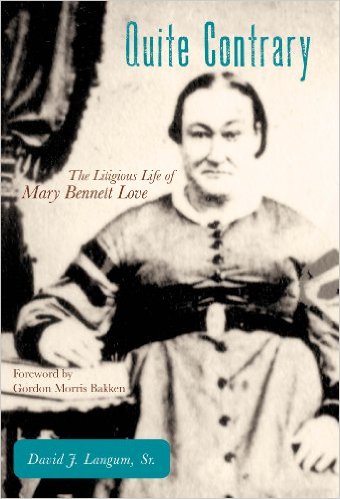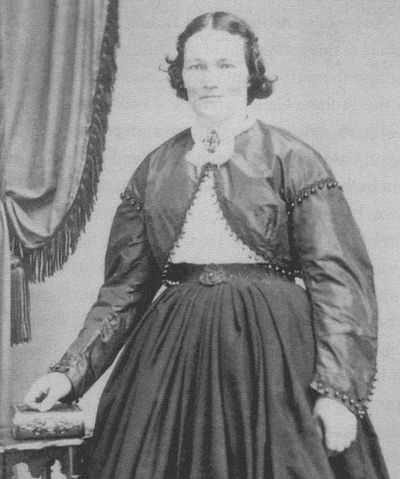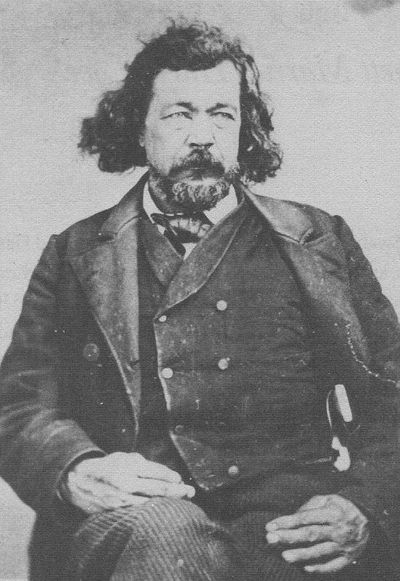Quite Contrary, The Litigious Life of Mary Bennett Love (2014 book)
Quite Contrary: The Litigious Life of Mary Bennett Love is a biography published in 2014 by David S. Langum Sr., a law professor at Samford University in Birmingham Alabama. Mary Bennett Love is an important figure in Santa Cruz County history - even though most of her life story took place outside of our county.
Born Mary Amanda McSwain in Virginia (1803), into an Irish family of very modest means, Mary met and married Vardamon Bennett in Georgia. The young couple and a growing family kept moving west - to Arkansas; then to Independence Missouri where they joined one of the earliest wagon trains to Oregon in 1842, led by Lansford Hastings. Still restless, the family moved south to California in 1843 - first to Sutter's Fort and eventually to the little port town of Yerba Buena, one of three settlements destined to be part of the future San Francisco.
The Bennetts, while not wildly prosperous, were getting along for a couple of years until, because of some not-well-explained marital difficulties, Mary decided to take the children and move south to the settlement around Mission Santa Clara. There she began a career as an independent entrepreneur, acquiring land first through land grants from the Mexican government, and later through preemptive claims ("squatting") filed with the new U.S. state of California after 1850.
In 1845, the Mary Bennett story came to what was soon to become Santa Cruz County. Mary's oldest daughter, 21-year-old Catherine, decided it was time to leave the nest. She moved to Monterey, staying briefly with the Thomas Larkin family, before suddenly marrying our own Isaac Graham - a man three years older than Catherine's mother. The two likely met through Catherine's older brother Winston, who was running farming operations for Graham. Graham's previous exploits are described elsewhere but, by this time, he had established himself as a successful ranchero, proprietor of Rancho Zayante, across the San Lorenzo River from modern Felton.
Mary's immediate unhappiness about the match began many years of feuding between the Bennetts and Grahams, but the deed was done. The rough-hewn frontiersman took his new bride back to his Zayante ranch, to commence a brief and stormy marriage. Two children helped to mitigate Mary's hostility for a few years, and Winston Bennett (aided by a couple of brothers) built his own sawmill a few miles up the San Lorenzo River from Zayante, on what later became known as Love Creek, for reasons we'll come to later.
A lot of other history was happening during the early marriage years of Isaac and Catherine Graham. In 1846, the Mexican-American War began, and the Monterey Bay area was one of the first areas occupied by U.S. forces (there hadn't been a Mexican military presence in Santa Cruz since the secularization of the mission in 1835). Still under U.S. military governorship, the Gold Rush of 1848 suddenly brought the world to northern California. The sudden influx of tens of thousands of fortune hunters from all over the world initiated a chaotic period, but the main effect in isolated Santa Cruz was that most able-bodied men headed off to the gold fields for a year or two. Isaac Graham was apparently not one of those, having already made his place in the world.
The Graham marriage was suddenly upended by the arrival of Isaac's son Jesse in 1850. It's unclear whether Catherine knew of Isaac's first family, but she was almost certainly surprised to learn that his first wife was still alive in Tennessee, a fact which made her children illegitimate. Catherine had had enough.
While Isaac and Jesse were away in San Jose on business, Catherine took the children and several thousands dollars' worth of Isaac's gold, possibly aided by her mother and/or brothers. Isaac and Jesse's search for Catherine and the gold led them to the Bennett sawmill. Shortly thereafter, the younger of the mill partners - another Bennett brother named Dennis - was killed in a gunfight with Jesse Graham (not the first Bennett-Graham gunfight). Charged with murder, Jesse disappeared, but Isaac's search continued.
Finally tracking her down a year later in Oregon, Isaac Graham went to get his gold, his children, and his wife - probably in that order. Recovering the remaining $3,000, Isaac took the children and returned to Zayante. Catherine followed, beginning more years of litigation in her attempts to regain custody of her children. By now, you probably understand why this story was of interest to a law professor. Catherine never returned to Zayante, dissolving her marriage with Graham. Mary Bennett, however, entered another chapter in Santa Cruz County history.
Everyone in northern California knew of Harry Love, first and only Captain of the California Rangers, who claimed (disputed) to have killed the notorious bandito Joaquin Murrieta. By 1854, at the age of 44, Love's career in law enforcement was over, and he began to look for other opportunities. It's unclear where and how he met the 50-year-old widow Bennett (Vardamon died in 1849), or whether they ever married, but by 1857 they were entering into contracts as husband and wife.
By that time, the couple had moved from Mary's house in Santa Clara to the sawmill property in the San Lorenzo Valley. What had been known as the "Bennett mill" became the "Love mill". We have no record of any further contacts with Isaac Graham (d. 1863), even though they lived only a few miles apart.
Love's efforts at milling and farming suffered a series of misfortunes, beginning with the winter floods of 1861-62, which washed the mill away. Those same floods destroyed the first Santa Cruz Powder Works and flooded downtown Santa Cruz. In later years, several fires destroyed Harry's buildings and crops.
Harry Love's last chance to find a place In Santa Cruz County passed when he unsuccessfully ran for Justice of the Peace in 1867. That same year, he moved back to Santa Clara and confronted Mary. The relationship between Mary and Harry seems to have been stormy at best. Mary moved back to Santa Clara in 1858, and sued for divorce in 1866. Thereafter, she felt threatened enough to hire a man to protect her from Harry. Harry died in 1868 after a shootout at Mary's house, and Mary died the same year of natural causes.
During the 1840s-50s, the population of Santa Cruz County rapidly swelled with new arrivals from the wagon trains and gold fields. Vardamon Bennett and his family came by way of the Oregon and California Trails. Isaac Graham came as a trapper, following southern trails. Harry Love came first by sea, returning later from Texas.
Many of these pioneers were bound to encounter each other before settling here. In Quite Contrary, several other names of future County residents appear. John Daubenbis crossed the plains in the same wagon train as the Bennetts, in 1846. The Adna Hecox family shared a miserable first California winter with the Bennetts at Santa Clara mission, 1846-47.
Note: Vardamon Bennett never lived in Santa Cruz County, although Mary and several of their children did. Mary's grave is in Watsonville (1803-1868). Vardamon and Mary's family should not be confused with the unrelated Eben Bennett, a "limeburner" in Felton in the 1860s. Also unrelated was Santa Cruz resident Silas Bennett.


